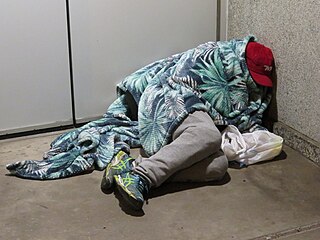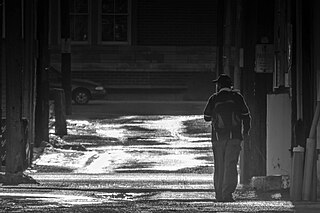
Lennox is a census-designated place (CDP) in the South Bay region of Los Angeles County, California, United States. The population was 22,753 at the 2010 census, down from 22,950 at the 2000 census.

Homelessness in Canada was not a social problem until the 1980s. The Canadian government housing policies and programs in place throughout the 1970s were based on a concept of shelter as a basic need or requirement for survival and of the obligation of government and society to provide adequate housing for everyone. Public policies shifted away from rehousing in the 1980s in wealthy Western countries like Canada, which led to a de-housing of households that had previously been housed. By 1987, when the United Nations established the International Year of Shelter for the Homeless (IYSH), homelessness had become a serious social problem in Canada. The report of the major 1987 IYSH conference held in Ottawa said that housing was not a high priority for government, and this was a significant contributor to the homelessness problem. While there was a demand for adequate and affordable housing for low income Canadian families, government funding was not available. In the 1980s a "wider segment of the population" began to experience homelessness for the first time – evident through their use of emergency shelters and soup kitchens. Shelters began to experience overcrowding, and demand for services for the homeless was constantly increasing. A series of cuts were made to national housing programs by the federal government through the mid-1980s and in the 1990s. While Canada's economy was robust, the cuts continued and in some cases accelerated in the 1990s, including cuts to the 1973 national affordable housing program. The government solution for homelessness was to create more homeless shelters and to increase emergency services. In the larger metropolitan areas like Toronto the use of homeless shelters increased by 75% from 1988 to 1998. Urban centres such as Montreal, Laval, Vancouver, Edmonton, and Calgary all experienced increasing homelessness.

In the United States, the number of homeless people on a given night in January 2023 was more than 650,000 according to the Department of Housing and Urban Development. Homelessness has increased in recent years, in large part due to an increasingly severe housing shortage and rising home prices in the United States.

Homeless shelters are a type of homeless service agency which provide temporary residence for homeless individuals and families. Shelters exist to provide residents with safety and protection from exposure to the weather while simultaneously reducing the environmental impact on the community. They are similar to, but distinguishable from, various types of emergency shelters, which are typically operated for specific circumstances and populations—fleeing natural disasters or abusive social circumstances. Extreme weather conditions create problems similar to disaster management scenarios, and are handled with warming centers, which typically operate for short durations during adverse weather.

Out of 10,000 female individuals 13 are homeless. Although studies reflect that there are many differences among women suffering homelessness and there is no universal experience, the average homeless woman is 35 years old, has children, is a member of a minority community, and has experienced homelessness more than once in their lifetime.

Affordable housing is housing which is deemed affordable to those with a household income at or below the median as rated by the national government or a local government by a recognized housing affordability index. Most of the literature on affordable housing refers to mortgages and a number of forms that exist along a continuum – from emergency homeless shelters, to transitional housing, to non-market rental, to formal and informal rental, indigenous housing, and ending with affordable home ownership.
Housing First is a policy that offers unconditional, permanent housing as quickly as possible to homeless people, and other supportive services afterward. It was first discussed in the 1990s, and in the following decades became government policy in certain locations within the Western world. There is a substantial base of evidence showing that Housing First is both an effective solution to homelessness and a form of cost savings, as it also reduces the use of public services like hospitals, jails, and emergency shelters. Cities like Helsinki and Vienna in Europe have seen dramatic reductions in homelessness due to the adaptation of Housing First policies, as have the North American cities Columbus, Ohio, Salt Lake City, Utah, and Medicine Hat, Alberta.
Homeless Management Information System (HMIS) is a class of database applications used to confidentially aggregate data on homeless populations served in the United States. Such software applications record and store client-level information on the characteristics and service needs of homeless persons. An HMIS is typically a web-based software application that homeless assistance providers use to coordinate care, manage their operations, and better serve their clients.
Housing discrimination refers to patterns of discrimination that affect a person's ability to rent or buy housing. This disparate treatment of a person on the housing market can be based on group characteristics or on the place where a person lives.

Homelessness or houselessness – also known as a state of being unhoused or unsheltered – is the condition of lacking stable, safe, and functional housing. The general category includes disparate situations, including:

In the Seattle King County area, there were estimated to be 11,751 homeless people living on the streets or in shelters. On January 24, 2020, the count of unsheltered homeless individuals was 5,578. The number of individuals without homes in emergency shelters was 4,085 and the number of homeless individuals in transitional housing was 2,088, for a total count of 11,751 unsheltered people.
Homeless veterans are persons who have served in the armed forces who are homeless or living without access to secure and appropriate accommodation.

Homelessness in the United States has occurred to varying degrees across the country. The total number of homeless people in the United States fluctuates and constantly changes hence a comprehensive figure encompassing the entire nation is not issued since counts from independent shelter providers and statistics managed by the United States Department of Housing and Urban Development vary greatly. Federal HUD counts hover annually at around 500,000 people. Point-in-time counts are also vague measures of homeless populations and are not a precise and definitive indicator for the total number of cases, which may differ in both directions up or down. The most recent figure for the year 2019 that was given was at 567,715 individuals across the country that have experienced homelessness at a point in time during this period.

Homelessness is a growing problem in Colorado and is considered the most important social determinants of health. Homelessness is very difficult for many Coloradoans to escape due to the continuous increase in costs for housing in Colorado, along with mental health treatments and other factors. When people are forced to live without stable shelter, they are then exposed to a number of risk factors that affect physical and mental health. Although it is difficult to pin point any one cause of homelessness, there is a complicated combination of societal and individual causes.

The United States Department of Housing and Urban Development estimated that more than 181,399 people were experiencing homelessness in California in January 2023. This represents more than 27% of the homeless population of the United States even though California has slightly less than 12% of the country's total population, and is one of the highest per capita rates in the nation, with 0.46% of residents being homeless. More than two-thirds of homeless people in California are unsheltered, which is the highest percentage of any state in the United States. 49% of the unsheltered homeless people in the United States live in California: about 123,423 people, which is eight times as many as the state with the second highest total. Even those who are sheltered are so insecurely, with 90% of homeless adults in California reporting that they spent at least one night unsheltered in the past six months.

In 2016, a report from the Department of Housing and Urban Development (HUD) revealed that the U.S. state of Oregon had an estimated homeless population of 13,238 with about 60.5% of these people still unsheltered. In 2017, these numbers were even higher. As of January 2017, Oregon has an estimated 13,953 individuals experiencing homelessness. Of this homeless population, 1,083 are family households, 1,251 are veterans, 1,462 are unaccompanied young adults, and 3,387 are individuals experiencing chronic homelessness. As of 2022, 17,959 people total experienced homelessness in Oregon, with 2,157 individuals being youth under 18, 6,671 being female, 10,931 being male, and 131 being transgender. Also among the 17,959 total homeless in 2022, 15,876 were Non-Hispanic/Non-Latino, 2,083 were Hispanic/Latino, 13,960 were white, 1,172 were Black, African American, or African, 101 were Asian or Asian American, 880 were Native American, and those of multiple race were 1,619. Oregon has seen an increase in its total homeless population consistently every year since 2010. In last three years specifically Oregon has seen a 98.5% increase 2021-2022, 22.5% increase 2020-2021, and a 13.1% increase 2019-2020.
The Point-in-Time Count, or PIT Count, is an annual survey of homeless people in the United States conducted by local agencies called Continuums of Care (CoCs) on behalf of the United States Department of Housing and Urban Development (HUD). HUD uses the data from PIT counts to evaluate the effectiveness of local agencies' efforts to address homelessness and to determine funding amounts for them, and also compiles this data into the Annual Homeless Assessment Report, which is provided to Congress. HUD defines the PIT as a "count of sheltered and unsheltered homeless persons carried out on one night in the last 10 calendar days of January or at such other time as required by HUD."

In October 2023, an average of 90,578 people slept in New York City's homeless shelters each night. This included 23,103 single adults, 32,689 children, and 34,786 adults in families. The total number is at its highest ever, with 63,636 people sleeping in homeless shelters. The city reported that in 2019, 3,600 individuals experienced unsheltered homelessness, sleeping in public spaces such as streets and public transit rather than shelters. The homeless population has surged in New York City 18% in 2023 from 2022, despite efforts from Mayor Adams.

The majority of Americans (64%) own their own homes, a rate that is less than the home ownership rates other large countries such as China (90%), Russia (89%), Mexico (80%), or Brazil (73%).

The 2022 Annual Homelessness Assessment Report (AHAR) to Congress, produced by The U.S. Department of Housing and Urban Development, estimated that 10,654 Ohioans faced homelessness during the year, representing 9 in every 10,000 individuals. Over 80% of the homeless were sheltered. This population was made up of 3,214 people who belonged to families with children, 703 unaccompanied youth, 633 veterans, and 1,023 chronically homeless individuals.













